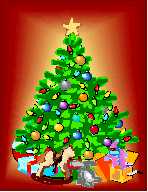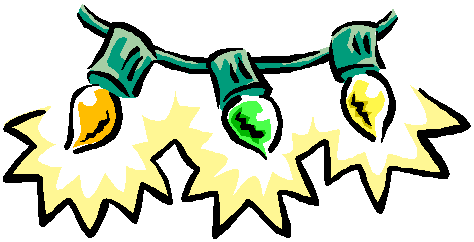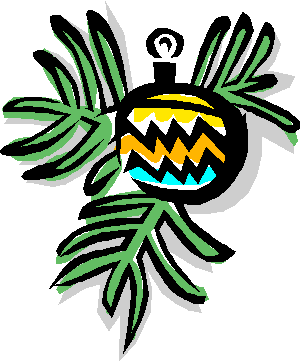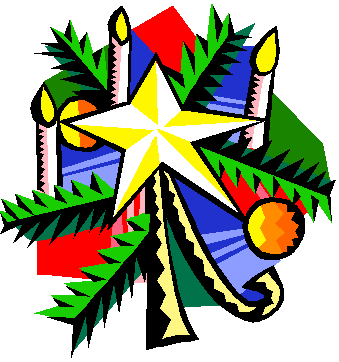

by� Phyllis Cambria
|
If you can store your tree in a cold, shady spot, buy it early.� This way you can keep it in water until you are ready to use it.� The trees on the lot are kept out of water from the time they are cut.� Making an early purchase will not only allow you a bigger choice of trees, you'll be able to get the tree into water sooner to help its preservation.� And a moist tree is less of a fire hazard than a dry one. |
�
|
�Instead of purchasing a cut tree from a lot, order a live tree from your local garden supply store or nursery.� The tree will arrive with its roots intact and likely wrapped in burlap or buried in soil.� Then simply insert the tree in a large, decorative pot.� Decorate as usual.� After the holidays, follow the instructions of your landscaper to plant the tree in your yard.� If you don't have a yard or don't want to plant the tree, you may be able to donate it to a local park or charity project. |
�
|
If you live near a "cut-your-own" Christmas tree farm, you'll know your tree is fresh. |
�
�


|
When selecting a tree, check the stump to see if there is still wet sap.� That will help prove the tree was freshly cut. | |
|
NOTE: �the lack of sap may only mean the tree has been stomped numerous times (see Stomp the Stump). |
|
Bend several needles, on different parts of the tree.� If they bounce back into shape, it means a fresher tree.� If they don't spring back into place, the tree is too dry. |
�
|
Lift the tree and stomp the stump several times on the ground.� If a number of needles fall off, it may mean the tree is too dry.� However, it can also mean that in transport the tree came in contact with several other dead or nearly dead trees and their old needles were caught on your tree's branches.� Don't rely on this test alone to determine if your tree is fresh. |
�
|
Be sure your tree's trunk is perpendicular at the top and bottom of the tree.� If it isn't, your tree may sit correctly in your stand and always appear crooked.� However, it's possible for the interior trunk to be bent in the middle, as long as it's straight at the top and bottom. |
�
|
Most tree lots will provide you with a fresh cut so that your tree will be able to absorb water.� However if they don't, you must make a fresh, straight cut with a saw 1-4 inches from the bottom of the tree. | |
|
Bring your tree stand to the lot with you to ensure that the tree you have chosen will properly fit the size stand you own. |
�



|
If possible, leave your tree outdoors in a cool, shady spot or your basement or garage for a day or two after you bring it home.� Since trees are tied together, it will give the branches a chance to relax and spread out making it easier to decorate.� Also, many trees will go into shock and may drop needles as it adjusts to being indoors.� Letting it stand for a day or two should resolve that problem or at least keep the mess off your carpet. |
�
|
Your tree has been out of water for a while and it's likely to be thirsty.� As soon as you have made the new cut, the tree will be able to drink up a good deal of water.� This is essential to help it stay fresh.� You may buy commercial products that will further help the tree to remain moist, or you can add a half cup of sugar to a gallon of water and use that mixture to soak your tree. | |
|
Check the tree's water level daily and replenish its supply often. It's likely that you will have to give it water at least once a day, possibly more often, for the first four or five days.� | |
|
Do not let the well go dry. Even if you refill it, the cut trunk may re-seal and it may be too late for your tree to absorb water again without a new cut being made. | |
|
�If it's difficult to pour the water into your tree stand's reservoir, use a turkey baster. | |
|
If the air in your home is very dry, mist your tree daily. Be sure to unplug any lights and do not turn them on again until water has been absorbed into the needles. |
�
|
Place your tree away from fireplaces, radiator or any other heat source.� | |
|
Keep it away from direct sunlight (if you have it near a window, draw your curtains during the sunniest times of the day) and out of drafts. |
|
Invest in a bag (usually only a dollar or two) that you can use to help dispose of your tree at the end of the season.� Spread it out according to the package directions and place your tree and stand inside.� Then, when you want to remove the tree, you simply lift it, tie the top and remove the tree.� The bag will help collect any dead needles while the tree is one display and will help contain the mess while you're disposing of the tree.� The bag is easily disguised with a tree skirt or fabric. |
�
|
While sticky sap means a fresh tree, it also can mean some tricky clean-up problems.� Here are some ways to help reduce the problem. |
�������� Vacuum fallen needles quickly before the sap can ruin your flooring or cause stains.
�������� If you find sap, use a commercial stain remover and a clean, white cloth (not one with a pattern or a different color whose dyes can increase the problem). Blot, don't rub.� �Do not use carbon tetrachloride, lighter fluid or gasoline.
�
������� If your tree is large, doesn't sit securely in the stand and/or�� is likely to be toppled by a pet or child, secure it.� Tie monofilament or string to one or more places on the trunk and fasten the line(s) to a wall hook, ceiling hook or a heavy piece of furniture.
��

|
Start with your lights.� |
�������� Be sure to check them before you place them on your tree.� It will be much easier to replace a burned out bulb or check wiring while they are stretched out rather than on the tree.
�������� Dispose of any strands with frayed or exposed wires.
�������� Do not string more than three strands together (or according to your light manufacturer's directions).
�������� It's easier to see how you are positioning the lights if they are plugged in when you start to wind them on the tree.
�������� If you have a tree topper that must be plugged in, start at the top and circle down.� Or use a separate cord for your tree topper and snake the cord down the back or center of the tree to camouflage it.� Otherwise, start adding your lights at the bottom of the tree.
�������� Use low-wattage bulbs that don't generate much (if any) heat.� If you don't, the lights' heat will dry out your tree sooner.
�������� Tuck some lights in toward the trunk to give your tree depth.
�������� Stand back, squint and look at the tree.� You'll be able to better see bare spots where the lights need to be adjusted.
�������� Never leave a lit tree unattended.
|
Ornaments |
�������� While it's often customary to add the tree topper last, it's actually easier to place it first.� Plus you're less likely to potentially knock off other decorations.
�������� Then place ornaments toward the trunk.� This will add depth to your design.� It's also a great place to tuck in older, heavier or sentimental ornaments which don't work with your overall theme but you want to continue using them.�
�������� After this, place ornaments on the outer ends of the branches.
�������� Never hang ornaments from your lights, especially if you're using metal hooks.
�������� Use slender ribbons to tie your ornaments to your tree instead of hooks.� Not only will it add extra design, the ornaments are less likely to get knocked or pulled off by a small child or pet.
�������� Once you have completed hanging all your ornaments, again, stand back and squint to look at your tree to detect bare spots.
�������� Add tinsel, garland and/or angel hair if desired.
|
Bare Spot Quick Fix |
�������� Buy a few stems of silk poinsettias or other plants or flowers and use to camouflage any gaps too big to be covered with a large ornament.� Be sure to tuck a few of these throughout the tree for uniformity and to make the use of them seem deliberate rather than trying to fix a problem area alone.
|
Once the holiday is over and it's time to remove the tree, follow these tips. |
�������� Work in reverse.� The last items you put up should be the first removed.
�������� Carefully remove your lights and wind them around the manufacturer's holder, one you've purchased especially made for this purpose, a piece of cardboard, or wind around gift wrap or paper towel tubes (then tuck the ends inside the tube).
�������� Rent a chipper or check with your local parks department or Christmas tree lot to see about recycling the tree for mulch.
�������� Store your tree stand in a separate, but easily accessible, spot.� This way if you buy your tree early next year, you won't have to dig through all of your decoration boxes to find the stand.
�